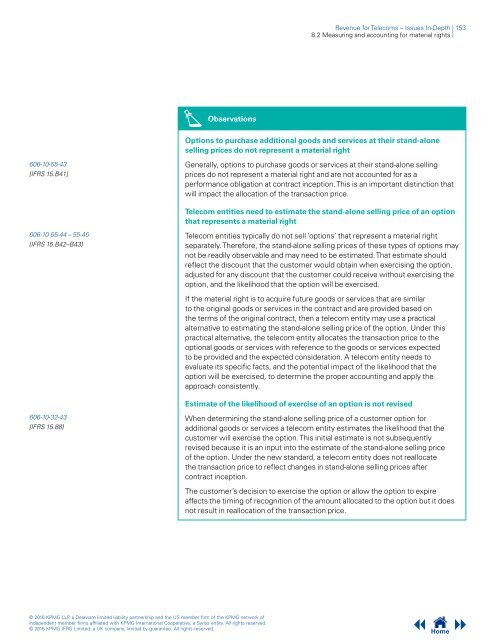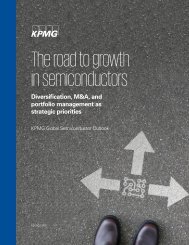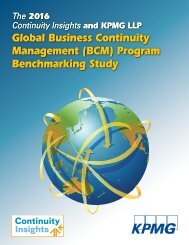Revenue for Telecoms
2cdncba
2cdncba
Create successful ePaper yourself
Turn your PDF publications into a flip-book with our unique Google optimized e-Paper software.
<strong>Revenue</strong> <strong>for</strong> <strong>Telecoms</strong> – Issues In-Depth | 153<br />
8.2 Measuring and accounting <strong>for</strong> material rights |<br />
Observations<br />
Options to purchase additional goods and services at their stand-alone<br />
selling prices do not represent a material right<br />
606-10-55-43<br />
[IFRS 15.B41]<br />
Generally, options to purchase goods or services at their stand-alone selling<br />
prices do not represent a material right and are not accounted <strong>for</strong> as a<br />
per<strong>for</strong>mance obligation at contract inception. This is an important distinction that<br />
will impact the allocation of the transaction price.<br />
Telecom entities need to estimate the stand-alone selling price of an option<br />
that represents a material right<br />
606-10-55-44 – 55-45<br />
[IFRS 15.B42–B43]<br />
Telecom entities typically do not sell ‘options’ that represent a material right<br />
separately. There<strong>for</strong>e, the stand-alone selling prices of these types of options may<br />
not be readily observable and may need to be estimated. That estimate should<br />
reflect the discount that the customer would obtain when exercising the option,<br />
adjusted <strong>for</strong> any discount that the customer could receive without exercising the<br />
option, and the likelihood that the option will be exercised.<br />
If the material right is to acquire future goods or services that are similar<br />
to the original goods or services in the contract and are provided based on<br />
the terms of the original contract, then a telecom entity may use a practical<br />
alternative to estimating the stand-alone selling price of the option. Under this<br />
practical alternative, the telecom entity allocates the transaction price to the<br />
optional goods or services with reference to the goods or services expected<br />
to be provided and the expected consideration. A telecom entity needs to<br />
evaluate its specific facts, and the potential impact of the likelihood that the<br />
option will be exercised, to determine the proper accounting and apply the<br />
approach consistently.<br />
Estimate of the likelihood of exercise of an option is not revised<br />
606-10-32-43<br />
[IFRS 15.88]<br />
When determining the stand-alone selling price of a customer option <strong>for</strong><br />
additional goods or services a telecom entity estimates the likelihood that the<br />
customer will exercise the option. This initial estimate is not subsequently<br />
revised because it is an input into the estimate of the stand-alone selling price<br />
of the option. Under the new standard, a telecom entity does not reallocate<br />
the transaction price to reflect changes in stand-alone selling prices after<br />
contract inception.<br />
The customer’s decision to exercise the option or allow the option to expire<br />
affects the timing of recognition of the amount allocated to the option but it does<br />
not result in reallocation of the transaction price.<br />
© 2016 KPMG LLP, a Delaware limited liability partnership and the US member firm of the KPMG network of<br />
independent member firms affiliated with KPMG International Cooperative, a Swiss entity. All rights reserved.<br />
© 2016 KPMG IFRG Limited, a UK company, limited by guarantee. All rights reserved.<br />
Home







